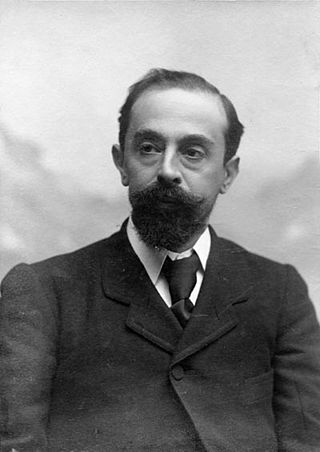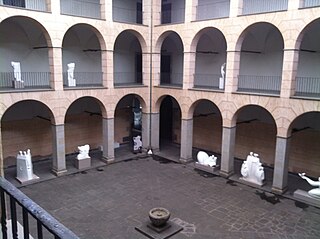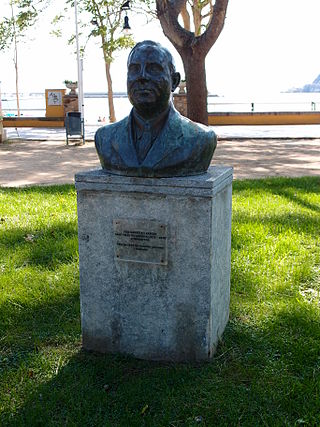
Modernisme, also known as Catalan modernism and Catalan art nouveau, is the historiographic denomination given to an art and literature movement associated with the search of a new entitlement of Catalan culture, one of the most predominant cultures within Spain. Nowadays, it is considered a movement based on the cultural revindication of a Catalan identity. Its main form of expression was Modernista architecture, but it also encompassed many other arts, such as painting and sculpture, and especially the design and the decorative arts, which were particularly important, especially in their role as support to architecture. Modernisme was also a literary movement.

Lluís Domènech i Montaner was a Catalan architect who was very much involved in and influential for the Catalan Modernisme català, the Art Nouveau/Jugendstil movement. He was also a Catalan politician.

The Museu Nacional d'Art de Catalunya, abbreviated as MNAC, is a museum of Catalan visual art located in Barcelona, Catalonia, Spain. Situated on Montjuïc hill at the end of Avinguda de la Reina Maria Cristina, near Pl Espanya, the museum is especially notable for its outstanding collection of romanesque church paintings, and for Catalan art and design from the late 19th and early 20th centuries, including modernisme and noucentisme. The museum is housed in the Palau Nacional, a huge, Italian-style building dating to 1929. The Palau Nacional, which has housed the Museu d'Art de Catalunya since 1934, was declared a national museum in 1990 under the Museums Law passed by the Catalan Government. That same year, a thorough renovation process was launched to refurbish the site, based on plans drawn up by the architects Gae Aulenti and Enric Steegmann, who were later joined in the undertaking by Josep Benedito. The Oval Hall was reopened for the 1992 Summer Olympic Games, and the various collections were installed and opened over the period from 1995 to 2004. The Museu Nacional d'Art de Catalunya was officially inaugurated on 16 December 2004. It is one of the largest museums in Spain.

Josep Carner i Puigoriol, was a Spanish poet, journalist, playwright and translator. He was also known as the Prince of Catalan Poets. He was nominated for the Nobel Prize in Literature seven times.

Joan Maragall i Gorina was a Catalan poet, journalist and translator, the foremost member of the modernisme movement in literature. His manuscripts are preserved in the Joan Maragall Archive of Barcelona.

The Library of Catalonia is the Catalan national library, located in Barcelona, Catalonia, Spain. The primary mission of the Library of Catalonia is to collect, preserve, and spread Catalan bibliographic production and that related to the Catalan linguistic area, to look after its conservation, and to spread its bibliographic heritage while maintaining the status of a center for research and consultation.
PICAP is a Catalan record label headquartered in Castellar del Vallès, Spain. It was founded in 1984.

Albert Ràfols-Casamada was a Spanish painter, poet and art teacher involved in the vanguard movements of his time. He is considered one of the most important, multifaceted Catalan artists of his time. His artwork began in the post-expressionist, figurative sphere but soon developed into his own abstract style grounded in a poetic rendering of everyday reality.

The Biblioteca Museu Víctor Balaguer is located in Vilanova i la Geltrú and was founded in 1884 by Víctor Balaguer so as to thank the city for its support during his politician career. Since 2000 the museum is part of the National Art Museum of Catalonia and the library is part of the National Library of Catalonia.

The Museu de la Garrotxa is a museum in Olot, Catalonia, Spain. It is associated with the Museu Nacional d'Art de Catalunya in Barcelona; the other institutions in this association are the Biblioteca Museu Víctor Balaguer and the Cau Ferrat (Sitges). The museum is housed in an 18th-century neoclassical building designed by architect Ventura Rodríguez.

The Palau Foundation is an art exhibition centre in the centre of Caldes d'Estrac, in the region of El Maresme (Catalonia). It was opened in May 2003, to exhibit and disseminate the art collection that had been compiled by Josep Palau i Fabre, as well as its archives and library. Of particular importance is its archive and bibliographical collection on Pablo Picasso. The Palau Foundation is part of the Catalan Art Museums Network and 'Espais Escrits', the Catalan Literary Heritage Network.

The Verdaguer House Museum is a literary museum in Folgueroles, birthplace of poet Jacint Verdaguer, in the region of Osona. It was opened in 1967 and is part of the Barcelona Provincial Council Local Museum Network.

Juli Garreta i Arboix was a Spanish composer, noted for his sardanes.

Can Framis is the latest Fundació Vila Casas museum, an art center in Barcelona devoted to the promotion of contemporary Catalan painting. Located in the old Can Framis factory complex, the museum displays more than 250 paintings from the sixties to the present made by artists born or currently living in Catalonia. In addition to the permanent collection which is divided in three floors, Can Framis Museum has an area dedicated to temporary exhibitions named Espai Aø. The permanent collection is updated periodically, and two new temporary exhibitions are opened every three months.

Isabel Steva i Hernández, whose pseudonym was Colita, was a Spanish photographer. She trained with Xavier Miserachs i Ribalta, and began her professional career in 1961 as a laboratory technician and stylist for Miserachs.

Josep Maria de Sagarra i de Castellarnau was a Catalan-language writer from Barcelona, Catalonia.

The Sala Parés is the oldest art gallery in Barcelona, Spain. Initially an art store, established in 1840 by Joan Parés, it slowly evolved into a gallery and formally became one in 1877.
Jaume Medina i Casanovas was a Catalan philologist, latinist, writer, translator and poet.

La Veu de Catalunya was a Catalan newspaper founded by Enric Prat de la Riba that was published in Barcelona from 1 January 1899 to 8 January 1937, with two editions daily.
Josep Benet i Morell was a Catalan politician, historian and publisher. Educated at the Escolania de Montserrat, from a very young age he participated in the Catalan nationalist movement and belonged to the Federation of Young Christians of Catalonia. One of the most prominent figures of political Catalanism in the XXth Century. As a parliamentarian, he was a member of the Committee of Twenty that drew up the preliminary draft of the Statute of Autonomy of Catalonia of 1979.


















